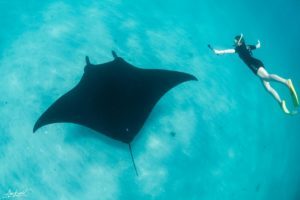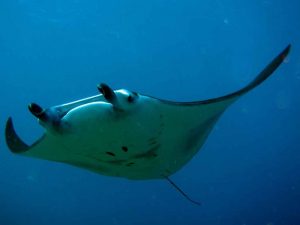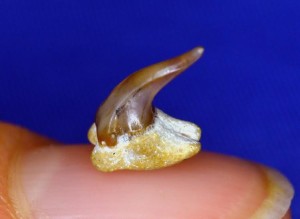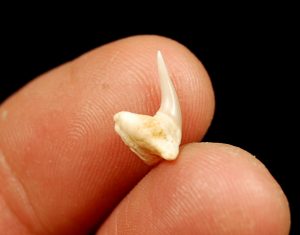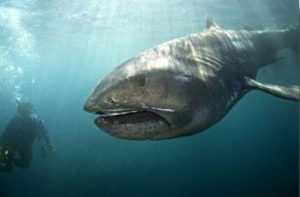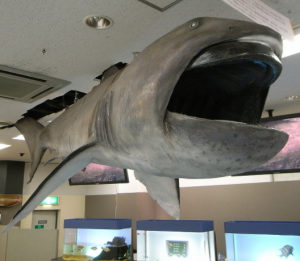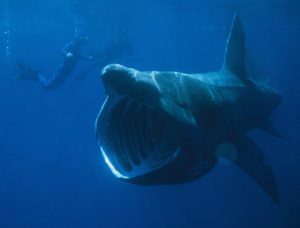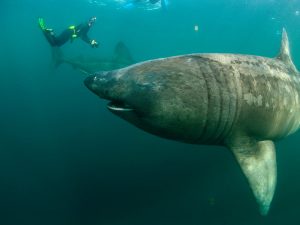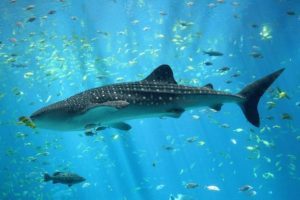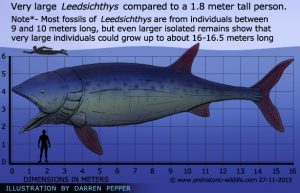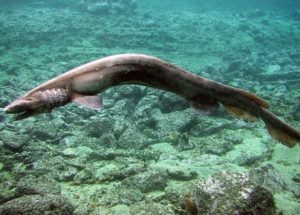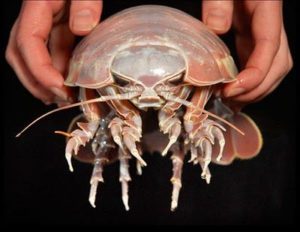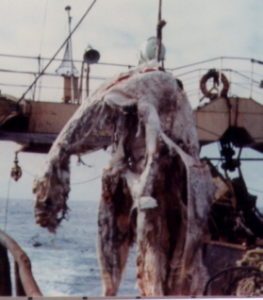Podcast: Play in new window | Download (Duration: 9:41 — 11.4MB)
This week we’re going to learn about some fish that feature warm-bloodedness! Thanks to Eilee for suggesting the moonfish, or opah.
Further reading:
The Opah Fish Is Warm-Blooded!
Basking Sharks Are Partially Warm-Blooded, New Research Suggests
Megalodon Was Partially Warm-Blooded, New Research Shows
The opah, or moonfish, looks like a pancake with fins but is an active swimmer [picture from first article linked above]:
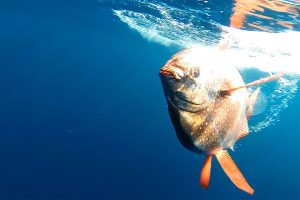
An opah not having a good day [photo by USA NOAA Fisheries Southwest Fisheries Science Center – https://swfsc.noaa.gov/ImageGallery/Default.aspx?moid=4724, Public Domain]:
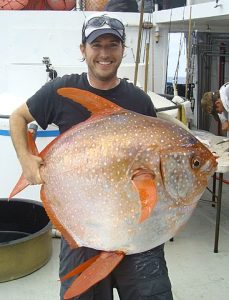
Show transcript:
Welcome to Strange Animals Podcast. I’m your host, Kate Shaw.
Months ago now, Eilee suggested we talk about the sunfish. We’re actually not going to talk about the sunfish this week, although it is on the list to cover eventually. Instead, we’re going to talk about something else in Eilee’s email. Eilee asked if there was a moonfish too, and not only is there a moonfish, it’s basically the most unique fish alive today in one particular way. It’s warm-blooded!
The moonfish is also called the opah. It’s golden-orange in color with little white spots, and it’s very round and flattened side-to-side, like a pancake with orange fins. It has big golden eyes and a tiny mouth. It’s also quite large, with the biggest species growing up to 6 and a half feet long, or 2 meters. That’s a really big pancake. It lives in the ocean, sometimes diving deeply, and despite looking like a pancake, it can swim very quickly to catch squid and small fish. It also eats krill. The reason it can swim so quickly is because it has huge muscles that power its fins, and the muscles also generate a lot of heat, enough to keep its entire body at least several degrees warmer than the surrounding water. This is a warm-blooded trait, but fish are supposed to be cold-blooded.
The scientific term for warm-bloodedness is endothermy. Mammals and birds are endothermic, meaning our internal body temperature stays roughly the same no matter what temperature it is outside. Cold-bloodedness, called ectothermy, means an animal’s internal body temperature fluctuates depending on the temperature outside its body. Reptiles, amphibians, fish, and invertebrates are all cold-blooded.
To us as mammals, it feels like warm-bloodedness is a really good idea, but it comes at a high cost. Mammals and birds have to eat a lot more and a lot more often than cold-blooded animals do, because keeping our body temperature steady takes a whole lot of energy. An endothermic animal generates heat mainly by metabolizing food, although muscle movements like shivering and running also generate heat. An endothermic animal can be as active at night as it is during the day, and can be as active in winter as it is in summer.
Some otherwise cold-blooded animals can generate enough heat with muscle movements to warm parts of the body, called regional endothermy, or can generate heat with muscle movements in certain situations, called facultative endothermy. The female of some species of snake, especially some pythons, will wrap her body around her eggs and shiver, which generates enough heat to keep the eggs warm. Bumblebees can also shiver to warm their bodies enough to allow them to fly in cold weather. At least some species of sea turtle, including the green sea turtle and the leatherback, generates enough heat in its muscles while swimming that it’s able to migrate long distances in very cold water. Some scientists think all marine reptiles may be regional endotherms to some degree.
Some fish demonstrate regional endothermy too. So far, 35 species of fish are known to be partially warm-blooded, including some species of tunas, sharks, and billfish. Scientists originally thought that only predatory fish needed the extra boost of speed and endurance that endothermy provides, but then they discovered the basking shark is regionally endothermic, and the basking shark is a filter feeder that doesn’t need to chase after fast-moving fish. Also, almost nothing eats it, so it’s not running from anything either.
The basking shark is also huge, one the largest sharks alive today. It can grow over 40 feet long, or more than 12 meters, and possibly longer, although most individuals are closer to 25 feet long, or around 7 1/2 meters. It mostly lives in cold waters, sometimes diving quite deeply but sometimes feeding at the surface of the ocean. It just goes where it can find lots of tiny food that it filters out of the water with structures called gill rakers. The basking shark just swims forward with its gigantic mouth open, water flows through its gills, and the gill rakers catch any tiny particles of food. The gill rakers funnel the food toward the throat so the shark can swallow it. It mostly swims slowly and isn’t a threat to anything in the ocean except the tiniest of tiny animals. So why does it need parts of its body to be warmer than the water it’s in?
Scientists think it may have something to do with how far the basking shark travels in a year, since endothermy provides more energy for endurance swimming. The basking shark migrates thousands of miles, presumably following the best conditions to find plenty of food, although we don’t know for sure. It could be that it prefers a specific type of environment to breed or have babies. In the summer basking sharks do congregate in groups even though the rest of the year they’re solitary. The female retains fertilized eggs in her body, where the eggs hatch and the babies continue developing until they’re born a few months later. Scientists think the unborn babies eat unfertilized eggs after the food in their yolk sacs runs out.
The basking shark is critically endangered and is protected in many countries, but because it migrates such long distances it doesn’t always stay where it’s safe. Learning more about it helps conservationists know how best to protect it, and that’s how scientists discovered it was regionally endothermic. It generates heat from muscles deep inside its body as it swims, which helps keep its organs warmer than the surrounding water.
Other sharks are known to share this trait, and in June of 2023, a new study about megalodon indicated that it was probably regionally endothermic too. Megalodon went extinct almost 4 million years ago and was so big that it makes even the largest great white shark look like a teeny little baby shark. I may be exaggerating a little bit. The great white’s teeth grow around 2 and a half inches long, or a little over 6 cm. Megalodon’s teeth were 7 inches long, or 18 cm. We don’t know how big Megalodon’s body was, but it could probably grow at least 34 feet long, or 10.5 meters, and possibly grew as much as 67 feet long, or 20 meters. It ate whales. Like the basking shark and some other living sharks, including the great white, the heat generated by its muscles as it swam would have kept its internal organs, eyes, and brain warmer than the water around it.
But the opah takes this a step farther. Instead of keeping parts of its body warm, it’s just full-on endothermic. It’s warm-blooded. It mainly generates heat by moving its muscles, and it retains heat with a layer of special fatty tissue around its gills, organs, and some muscles. It also has a heat exchange system in its blood vessels that’s incredibly efficient. Cold water flowing through the gills chills the blood, but as the chilled blood flows deeper into the body, it’s warmed up by passing closely alongside heated blood flowing out from the heart. As a result, the opah can maintain its body temperature even when spending lots of time in cold water.
We actually don’t know that much about the opah, even though it’s a fish people like to catch and eat. It was described scientifically in 1799, which means it took well over 200 years for scientists to figure out that it was a warm-blooded fish. That means it’s very likely that it’s not the only endothermic fish alive today, it’s just the only one we’ve found so far.
You can find Strange Animals Podcast at strangeanimalspodcast.blubrry.net. That’s blueberry without any E’s. If you have questions, comments, or suggestions for future episodes, email us at strangeanimalspodcast@gmail.com. We also have a Patreon at patreon.com/strangeanimalspodcast if you’d like to support us for as little as one dollar a month and get monthly bonus episodes.
Thanks for listening!

